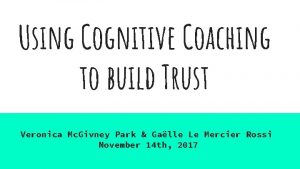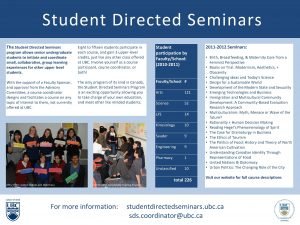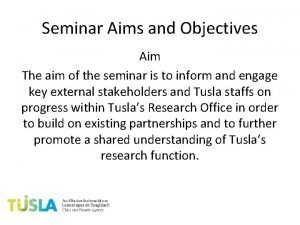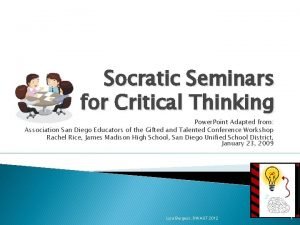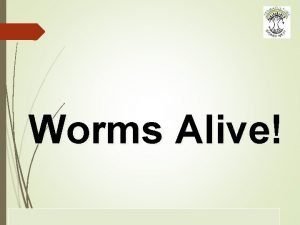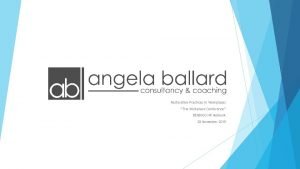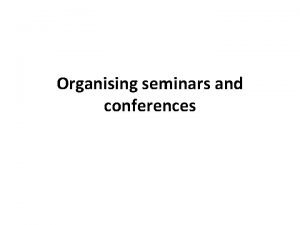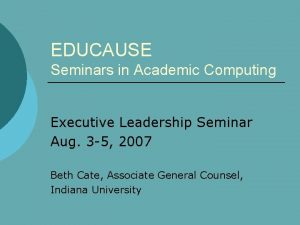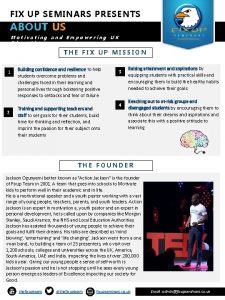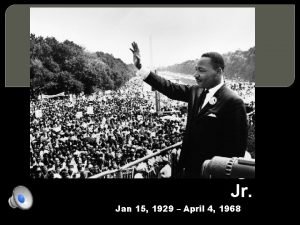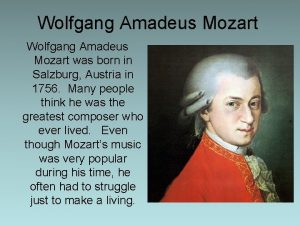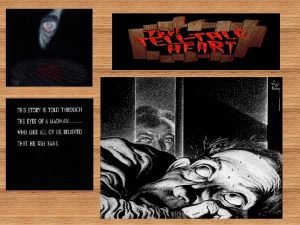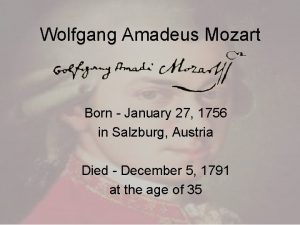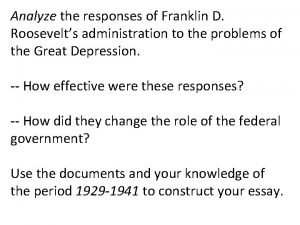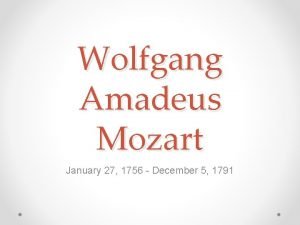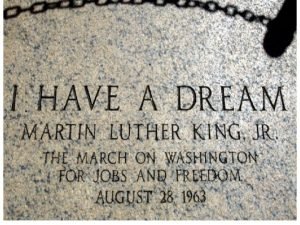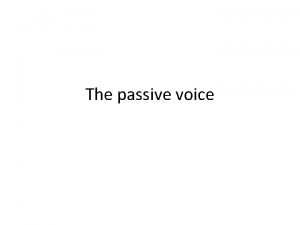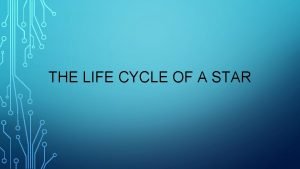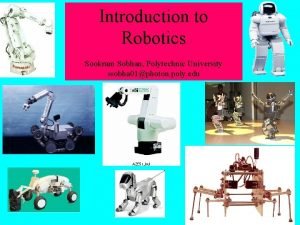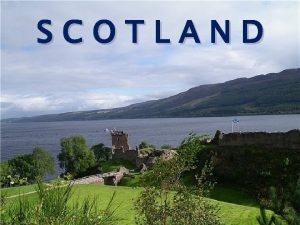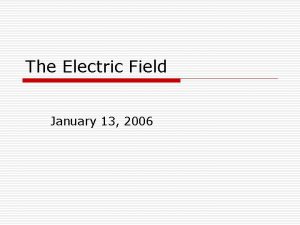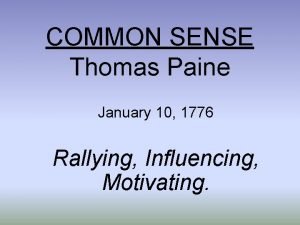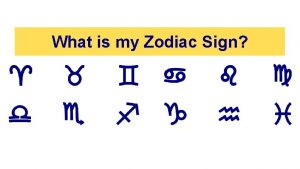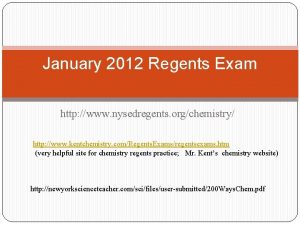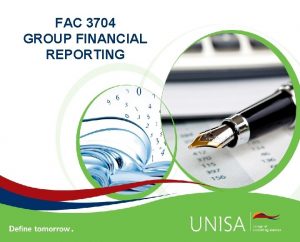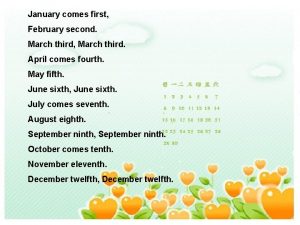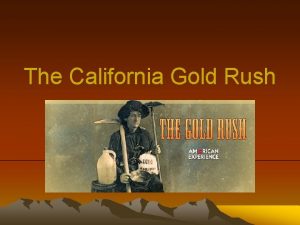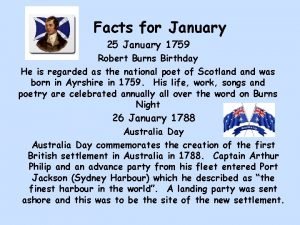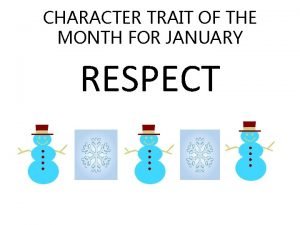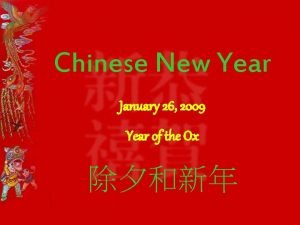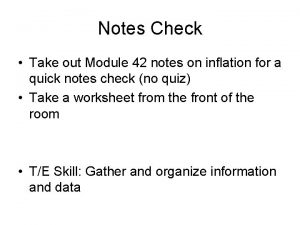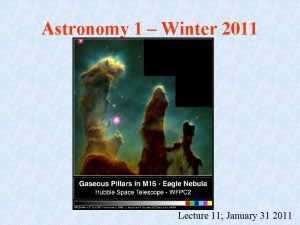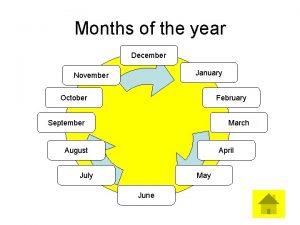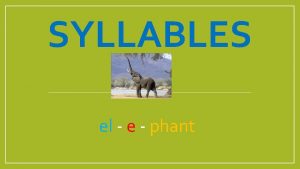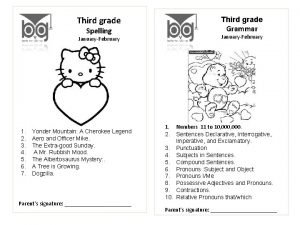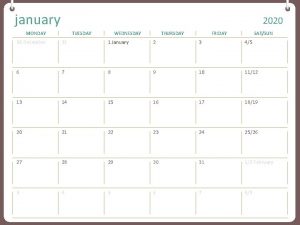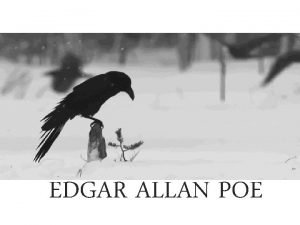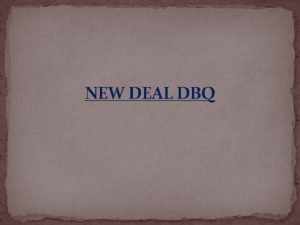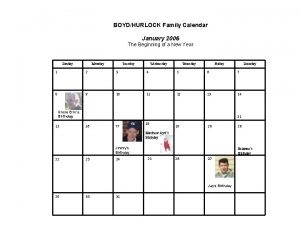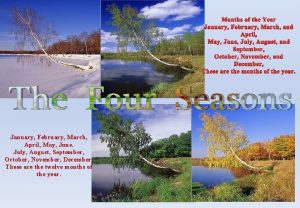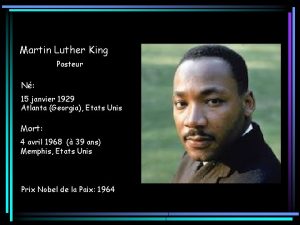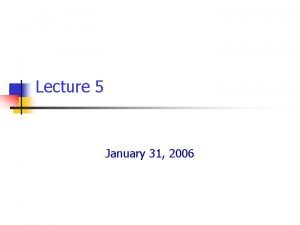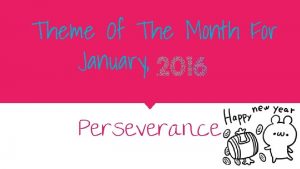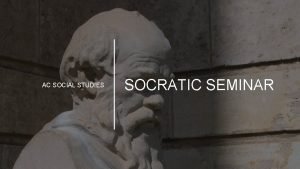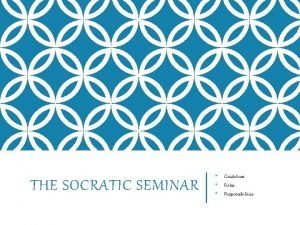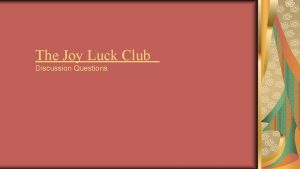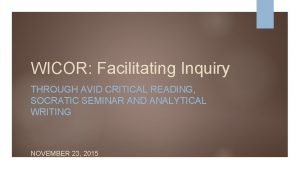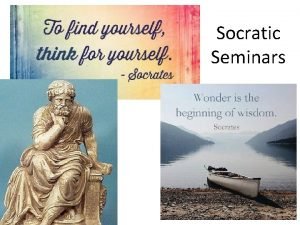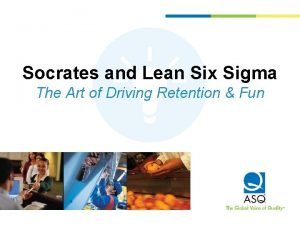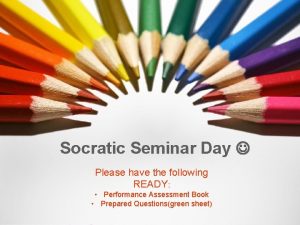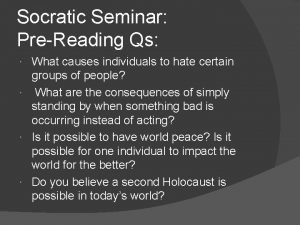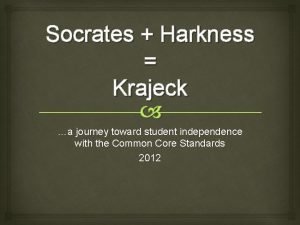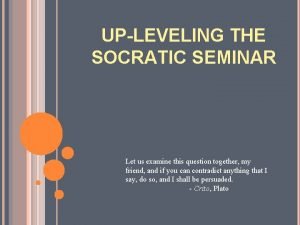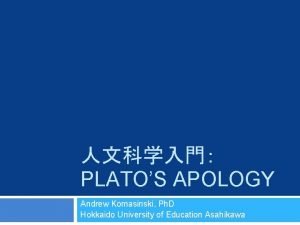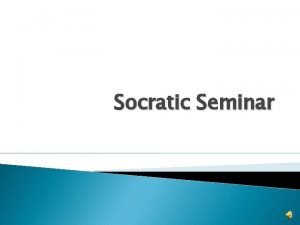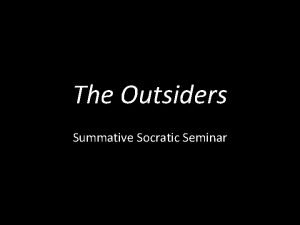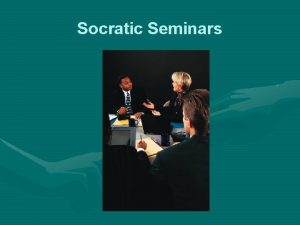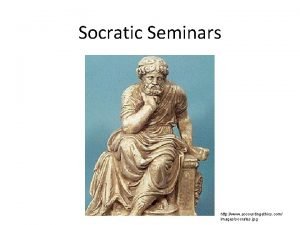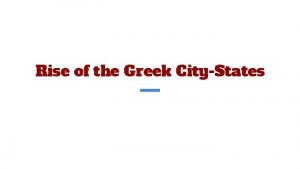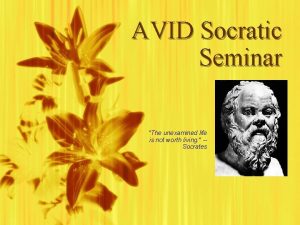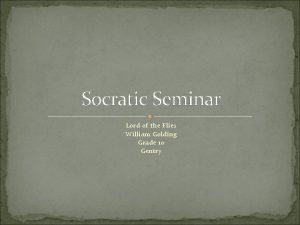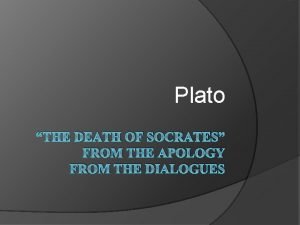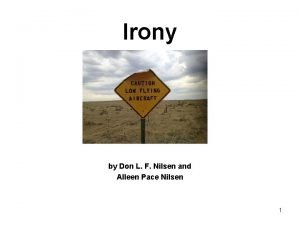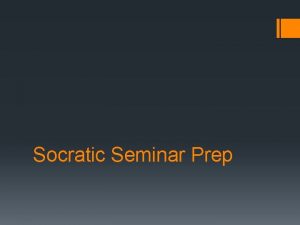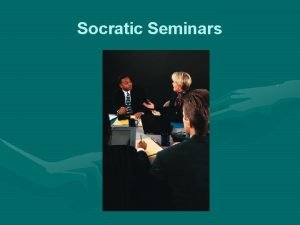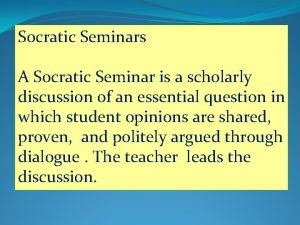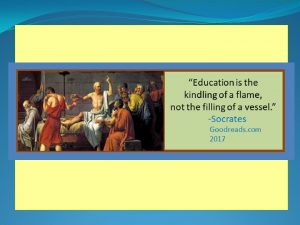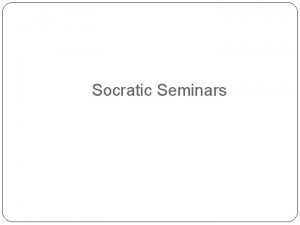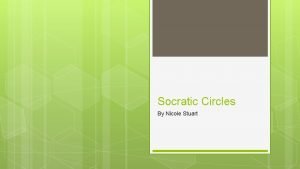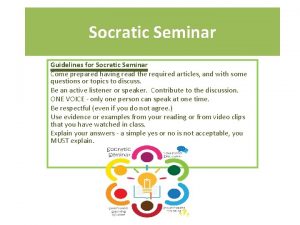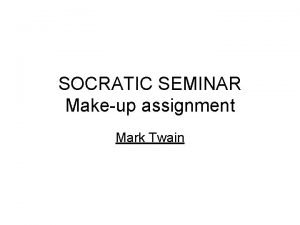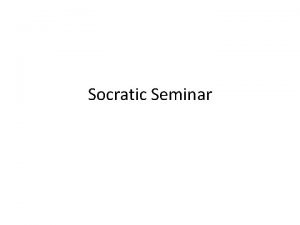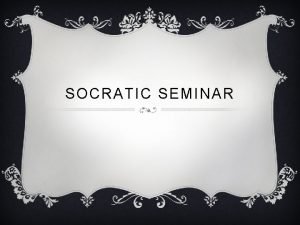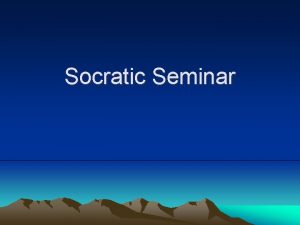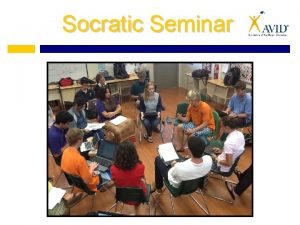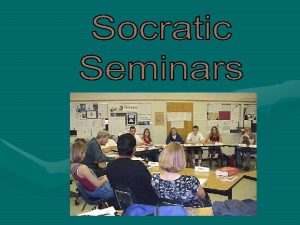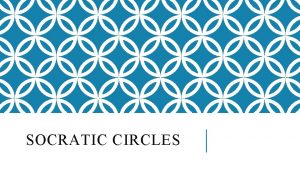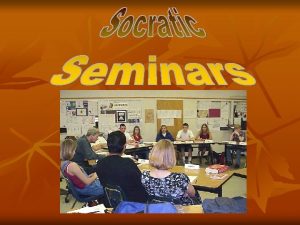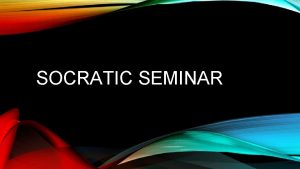Week 20 January 28 31 2014 Socratic Seminars





















































































- Slides: 85

Week 20: January 28 -31, 2014 Socratic Seminars on Chapters 12 -14 1920 s, Great Depression Americans, Ch. 12 -14 History Alive!, Ch. 26 -32

Homework: Enhance Ch. 12 notes & prepare for Ch. 13 Socratic Seminar; complete BOTH video worksheets by Thursday Per. 4 & 6: Continue midterm essay WORK Tuesday, January 28, 2014 I. Social Studies Business Quarter #2 ends TODAY…prepare BOTH video worksheets Per. 1 & 3 ONLY: Review answers via PPT MNR New Deal Cards (5 points each) past due! II. Chapter 12: Politics of the Roaring Twenties Socratic Seminar #1 of 4 Americans, p. 410 -431; Alive!, Ch. 26 & 27 Unit III study items/observation sheet…NOTES!

Why are we here TODAY? Students will review SS business related to the end of the 2 nd marking period and prepare to exhibit Safari Montage video worksheets on the Roaring 1920 s and the Great Depression and New Deal. Chapter 12: The Politics of the Roaring Twenties (Socratic Seminar #1 of 4) will occur in all class periods, as student observers complete their study guide/outline in preparation for upcoming unit assessments.

FYI… all dates subject to change • Ch. 12, 13, 14, OR 15 tests (20 major pts) LAST CALL for SCL if <14/20 pts! • Socratic Seminars (Ch. 12 15) Tues. 1/28 Fri. 1/31 3 rd quarter 40 -pt. major • MNR’s New Deal “game cards” are past due! • 1920 s Celebrity “Dance Party” ? ? …props & Charleston moves required! • Midterm essay academic Per. 4 & 6 ONLY Today Tues. Feb. 4 th…Lab 341 • Unit III district assessment is Friday, February 7 th • Robinson’s Ch. 12 -15 test will be Tuesday, February 11 th



What was ROARING in post-World War I America in the 1920 s? “The return to normalcy ushered in an exciting new era, including the start of the automobile culture, flappers and the revolution in manners and morals. The consumer revolution, the rise of advertising and motion pictures, the Harlem Renaissance, the Jazz Age and the golden age of sports were all glamorous new aspects of American life. Meanwhile, social polarization, prohibition, the Scopes Trial and the rebirth of the KKK represented the more sober social realities. ”

ratification The Roaring 1920 s normalcy innovations women international prosperity automobile international Americans turned away from affairs in the aftermath of World War I, an attitude reflected in newly elected President Warren G. Harding’s call for a return normalcy to “ . ” The country’s focus shifted instead to the material benefits associated with America’s unprecedented postwar Spurred by new inventions and technological prosperity innovations States’ economy was in the midst of a third industrial revolution. The . , the United automobile became a dominant feature of America’s new consumer culture and created a more mobile society, and consumer goods such as electrical appliances caused fundamental changes in daily life. Along with the consumer revolution came dramatic cultural changes, especially for women . With the ratification of the 19 th Amendment, women experienced increased participation in public affairs, improved educational and employment opportunities and enjoyment of the many glamorous aspects of the Roaring Twenties.

The Roaring 1920 s nativist Harlem Renaissance jazz sports flight revival temperance pivotal The motion picture industry was born and quickly assumed a role in American culture. Americans were also entertained by jazz pivotal music, just one aspect of the emergence of a distinctively African-American culture, known as Harlem Renaissance the . Heroes from the “Golden Age of sports ” led by Babe Ruth and Jack Dempsey excited flight many, and Charles Lindbergh thrilled the world with his daring . However, old social tensions flared up during this period of rapid cultural change. Temperance advocates had succeeded in making Prohibition the law of the land, but enforcement proved very difficult. The Ku Klux Klan revival experienced a strong nativist as un-American, and , expressing hatred towards those they regarded groups rejected many elements of the new culture that they believed were destroying American values.

The Roaring 1920 s gap prosperity stocks The excitement generated by the economic production prosperity of the time tended to overshadow underlying weaknesses such as high speculation in stocks , cutbacks in industrial gap production and the increasing between rich and poor. The causes for an abrupt end to the economic optimism of the Roaring Twenties were in place. “Nothing in the world can take the place of persistence. Talent will not; nothing is more common than unsuccessful men with talent. Genius will not; unrewarded genius is almost a proverb. Education will not; the world is full of educated derelicts. Persistence and determination are omnipotent. The slogan 'press on' has solved and always will solve the problems of the human race. ” Calvin Coolidge

Use the documentary video, OTHER internet resources, and your books to fill in the blanks below. assembly 1913 — Henry Ford sets up the first moving line. 1913 — John Watson publishes Psychology as the Behaviorist Views It. 1914 — Marcus Garvey founds the Universal Negro Improvement Association. alcohol 1919 — The 18 th Amendment, prohibiting the sale of vote 1920 — Women gain the right to with ratification of the 19 th Amendment. cities 1920 s — For the first time, more Americans live in than in the countryside quota 1924 — The Immigration Act establishes the first national origins 1925 — The Scopes trial system. is held in Tennessee. 1927 — Duke Ellington brings his band to the 1927 — The Jazz Singer, the first “talkie” Cotton movie 1927 — Charles Lindbergh is first to fly solo across the 1929 — The stock market , is ratified. crash Club in Harlem. , is released. Atlantic Ocean. signals the end of the Roaring Twenties.

Vocabulary Progressivism — An American reform movement within both major political parties, from about 1890 to World War I, that pressed for legislation to reform many aspects of America’s urban and industrial systems. “The Jazz Age” and “The Roaring Twenties” — Terms used by historians to characterize the decade of the 1920 s. Third Industrial Revolution — The shift in the 1920 s towards relying on electricity for power and utilizing the assembly line for the mass production of consumer goods. Model T— A reliable, affordable car that was designed, manufactured and sold by Henry Ford. It became one of the most popular American made cars in history. mass consumer culture — The desire of producers to sell, and of consumers to buy, the many new products developed in the 1920 s, such as electrical appliances. 19 th Amendment — The Constitutional amendment that gave women the right to vote. Speakeasies — Places where alcoholic drinks were sold illegally during the time of Prohibition. Flappers — Young women of the 1920 s who sought to liberate themselves from old social rules and customs and to enjoy life fully and on a basis equal with men. snake oil salesmen — A term used to describe dishonest salesmen in traveling medical shows or in country fairs, who sold bottles filled with worthless mixtures as medicinal cures.

Vocabulary Universal Negro Improvement Association — A large African American organization founded by Marcus Garvey to promote self pride, economic , and the formation of an independent nation in . Harlem Renaissance — An outpouring of literary and musical creativity by African Americans in the 1920 s, centered in City. The Cotton Club — A popular nightclub in Harlem where patrons came to enjoy entertainment by African American performers, including Duke Ellington. — A form of melancholy music originated by African Americans in the South. Blues Africa New York racial -sufficiency white

Vocabulary Prohibition — A time in American history, following the passage of the 18 th Amendment, when it was illegal to produce, transport or consume alcoholic beverages. Ku Klux Klan — A secret terror organization dedicated to white supremacy, first organized in the South after the Civil War. nativism — A postwar phenomenon characterized by Americans’ distrust of foreigners and foreign influence. “Golden Age of Sports” — A time in the 1920 s when sports became tremendously popular and top athletes like Babe Ruth, Jack Dempsey, Bill Tilden, and Red Grange became sports heroes. Scopes trial — A controversial trial in which John Scopes, a high school teacher, was convicted of breaking a Tennessee law outlawing the teaching of evolution. The Gospel of Business — During the boom of the 1920 s, the strong belief in American corporations and prosperity, best expressed by President Calvin Coolidge, that “The chief business of the American people is business. ”

Safari Montage Documentaries Roaring 1920 s and Great Depression & New Deal • Each worksheet = 5 minor points Q: Period 1 & 3: Did you watch the Great Depression and New Deal video? A: At least be sure to complete the worksheet (5 points) by Thursday, 1/30

“The Great Depression & New Deal” • “This program explores the causes of the Great Depression and the impact of the stock market crash as hard times fell on America. It also covers the New Deal, the Dust Bowl and the newly emerging culture of sight and sound. As the New Deal came under fire, the Second New Deal was issued, the Wagner Labor Act was passed, the unions gained power and a modern welfare state was born. ” Complete the worksheet AND your cards today!

“The Great Depression & New Deal” The prosperity of the Roaring Twenties ended as the Stock Market Crash of 1929 ushered in one of the worst economic depressions in history. Although the causes of the Great Depression were clear to many, solutions to problems such as high unemployment and extreme poverty proved to be elusive. President Herbert Hoover tried to alleviate some of the suffering, but his traditional methods did nothing to improve economic conditions. The 1932 presidential election brought Franklin D. Roosevelt to the White House. He promised a “New Deal” to the American people and embarked on a course to restore confidence in the nation’s financial system and to get people back to work. The programs of the Roosevelt administration sought to bring relief to all segments of the economy and were quickly passed by Congress. President Roosevelt’s “fireside chats” convinced the American people he was on their side and First Lady Eleanor Roosevelt became known as a tireless advocate of the poor and downtrodden.

“The Great Depression & New Deal” The decisions of the Supreme Court to declare key measures of the first New Deal unconstitutional were severe blows to the Roosevelt Administration’s plan. Also, conservative Americans lobbied against what they saw as the New Deal’s reckless spending and socialist reforms, while more radical New Deal critics questioned the viability of American capitalism and embraced socialist or even communist solutions to the economic crisis. Roosevelt launched the second New Deal that included key legislation like the Social Security Act and the Wagner Act which made long and lasting changes to the nation.

“The Great Depression & New Deal” After his landslide reelection in 1936, Roosevelt’s attempt to pack the Supreme Court with supporters of his New Deal policies failed and the stubborn ravages of the Depression led to new attempts to bring relief through increased federal spending. Eventually, the need to rearm for World War II brought an end to the Great Depression and solidified the reforms of the New Deal. Its legacy would be the assumption of responsibility by the federal government for the health of the economy and for the welfare of its people.

Time Line 1920 s — The United States enjoys an unprecedented economic boom. 1928 — Herbert Hoover is elected president. 1929 — The stock market collapses. 1931 — Several unemployed men are killed in protests at Ford’s River Rouge plant. 1932 — The unemployment rate in the United States reaches approximately 25%. 1932 — Franklin Delano Roosevelt is elected president. 1933 — The first New Deal legislation begins to be enacted. 1934 — Great Plains dust storms blow soil as far east as Washington, D. C. 1934 — The Supreme Court rules the National Industrial Recovery Act unconstitutional. 1935 — The second New Deal begins. 1935 — The Social Security Act is signed into law. 1936 — President Roosevelt is reelected. 1938 — Congress authorizes federal deficit spending to stimulate the struggling economy. 1940 — President Roosevelt is elected to an unprecedented third term.

Vocabulary Roaring Twenties — A term used to describe the economic boom of the 1920 s. Stock market crash (1929) — The precipitous decline of the stock market on October 29, 1929 that ushered in one of the worst economic depressions in history. Great Depression — The time period from around 1929 to 1939 in which many people suffered from extreme poverty as a result of high unemployment. Hoovervilles — A derogatory name given to Depression era shacks where poor people lived when Herbert Hoover was president. trickle down theory — An economic theory that states when taxes are cut for business owners, money will eventually trickle down to the poor in the form of new jobs. Reconstruction Finance Corporation (RFC) — A U. S. Government Agency formed by Congress to give financial aid to banks and businesses and to support public works projects during the Depression. first New Deal — Name given to the set of laws initiated by President Roosevelt in 1933 and 1934 to fight the Depression. National Industrial Recovery Act (NIRA) — The first of the New Deal measures enacted to help businesses recover from the Depression. The Act created a new administrative bureau called the National Recovery Administration, or NRA. Dust Bowl — The calamitous soil erosion caused by the removal of grasslands and severe droughts that ruined many farms and farmers in the Great Plains in the 1930 s. Agricultural Adjustment Administration — A government agency formed during the New Deal to give aid to struggling farmers. Civilian Conservation Corps (CCC) — A New Deal agency formed to put young unemployed men to work on federal conservation projects. Works Progress Administration (WPA) — A New Deal agency formed to put the unemployed to work on federal projects.

Vocabulary “Black Cabinet” — A group of leaders consulted by Eleanor Roosevelt about issues of unemployment and poverty among African Americans during the Depression. “Blue Eagle” codes — Controversial measures taken by the National Recovery Administration to help businesses. The Blue Eagle was the symbol of the NRA, which was often criticized for discriminatory rules against African Americans. Commerce Clause — The power given to the federal government to regulate commerce between the states, but not within the states. American Liberty League Organization — A group formed by business leaders and by the wealthy to fight against the reforms of the New Deal. Communist Party — A radical political party that questioned the system of capitalism and attracted support in America during the Great Depression. second New Deal — A new set of New Deal relief measures enacted in 1935, chief of which was the Social Security Act — Far reaching legislation of the New Deal that provided a federal old age and unemployment insurance system. National Labor Relations Act — Also called the Wagner Act, a New Deal law passed in 1935 that required companies to bargain with unions chosen by the workers. court-packing — An unsuccessful attempt by President Roosevelt to increase the number of justices on the U. S. Supreme Court to prevent having New Deal measures declared unconstitutional. Fair Labor Standards Act — One of the last New Deal laws passed in 1938 to set a national minimum wage and maximum work week hours.

Homework: Enhance Ch. 12 & 13 notes; prepare for Ch. 14 Socratic Seminar Per. 4 & 6: Continue midterm essay WORK Wednesday, January 29, 2014 I. FINISH Chapter 12: Politics of the Roaring Twenties Socratic Seminar #1 of 4 Americans, p. 410 -431; Alive!, Ch. 26 & 27 Unit III study items/observation sheet…NOTES! II. Chapter 13: The Roaring Life of the Twenties Socratic Seminar #2 of 4 Americans, p. 432 -461; Alive!, Ch. 28 & 29

Why are we here TODAY? Students will complete the Socratic Seminar for Chapter 12: The Politics of the Roaring Twenties (Socratic Seminar #1 of 4) will occur in all class periods, as student observers complete their study guide/outline in preparation for upcoming unit assessments. Chapter 13: The Roaring Life of the Twenties will also occur (time permitting).

Homework: Enhance Ch. 13 & 14 notes; prepare for Ch. 15 Socratic Seminar…READ textbooks & take notes Per. 4 & 6: Organizer/planning worksheet checked Monday! Thursday, January 30, 2014 I. FINISH Chapter 13: The Roaring Life of the Twenties Socratic Seminar #2 of 4 Americans, p. 432 -461; Alive!, Ch. 28 & 29 Unit III study items/observation sheet: NOTES…ASK ? S II. Chapter 14: The Great Depression Socratic Seminar #3 of 4 Americans, p. 462 -485; Alive!, Ch. 30 -32 Unit III study items/observation sheet…NOTES!

Why are we here TODAY? Students will complete the Socratic Seminar for Chapter 13: Life in the Roaring Twenties (Socratic Seminar #2 of 4) will occur in all class periods, as student observers complete their study guide/outline in preparation for upcoming unit assessments. Chapter 14: The Great Depression will also occur (time permitting).

Homework: Enhance Ch. 14 & 15 notes; prepare for Ch. 15 Socratic Seminar…READ textbooks & take notes Per. 4 & 6: Organizer/planning worksheet checked Monday! Friday, January 31, 2014 I. Chapter 14: The Great Depression Socratic Seminar #3 of 4 Americans, p. 462 -485; Alive!, Ch. 30 -32 Unit III study items/observation sheet…NOTES…ASK ? s II. Midterm Essay and/or MNR New Deal “Practice” Per. 1, 3, 5: volunteers game cards Per. 4 & 6: planning worksheet: theme? 3 historic examples

Why are we here TODAY? Students will complete the Socratic Seminar for Chapter 14: The Great Depression (Socratic Seminar #3 of 4) will occur in all class periods, as student observers complete their study guide/outline in preparation for upcoming unit assessments. Students will practice using MNR New Deal game cards and/or continue preparations for the upcoming midterm essay (academic only).

Socratic Seminar

Unit III District Exam Items The 1920’s, Great Depression, New Deal Red Scare Great Migration Harlem Renaissance Scopes Trial Role of women Reemergence of the KKK Mass Media Superficial wealth Friday, 2/7 Great Depression Causes Effects Dust Bowl Hoover’s response to the Depression Philosophy Tariffs New Deal Philosophy Key programs (AAA, FDIC, Social Security) Legacy Criticisms of the New Deal

MNR’s New Deal: A challenging cranial endeavor! OBJECTS of the GAME Demonstrate your understanding of *UNIT III by CONSTRUCTING game cards, * then PLAYING a fast paced, competitive game that tests your ability to score points by drawing, recalling, acting, deciphering, etc. *THREE, chapter specific CARDS will be created by each student from the Americans and/or History Alive! MATERIALS Each chapter group will "equitably" divide the chapters from The Americans and History Alive! so that each student has 3 unique & specific CONCEPTS: vocabulary terms, people, events, laws, etc. Each individual student will construct 3 playing cards (on 3 x 5 index cards) in three different styles described below: sketcher: list SIMPLE, easy-to-draw things, followed by 3 "clues" or drawing ideas…. like Pictionary (players will DRAW and their teammates will try to GUESS what you have listed) actor: list any specific person, event, or concept that could be dramatized (with or without words)…. like charades (you must list a few suggested actions, phrases, or hints…your may have forbidden words if you choose no-know? : list concept, esp. challenging ones, followed by 5 obvious related words that cannot be said…like CAT cannot say feline, mouse, dog, kitty, or furry…bulleted list of prohibited words Taboo orwd: scramble the letters of a fairly challenging concept, then write a definition beneath it…who/what am I? dunsternadgin Ability to know and appreciate wise & important things imagine: draw or arrange picture(s) or clip art representing a specific concept, then EXPLAIN…who/what am I? (during game teams try to GUESS what your picture represents…”fill” white side of card) INCLUDE your NAME, Period #, and CHAPTER (12, 13, 14, or 15) on your cards!!!

Unit III: 1920 s, Great Depression, & New Deal Essential Questions What happens when traditional and modern cultures interact? What influences do economic excesses have on American society? What is the proper role of the government in people’s lives? Did America move closer to or further away from its founding ideals during the interwar period? Enduring Understandings Cultural patterns established between the world wars are still relevant today. Conflict occurs when people perceive that traditional values and culture are threatened by modern changes. Economic excess and the unequal distributions of wealth can lead to instability in society. Liberals and Conservatives have different beliefs about individual responsibility and the proper role of the government. As a result of the New Deal, the United States government took on greater responsibilities for promoting the general welfare.

Essential Questions What happens when traditional and modern cultures interact? What influences do economic excesses have on American society? What is the proper role of the government in people’s lives? Did America move closer to or further away from its founding ideals during the interwar period? What happens when traditional and modern cultures interact? • The clash between traditional moral values and changing ideas were exemplified in the controversy over Prohibition, the Scopes trial, and the emergence of the “New Woman. ” • Rising tensions including, the resurgence of the Ku Klux Klan, and the rise of socialism/communism. • How different forms of mass media created consumerism and mass culture. • Contributions of artists and writers of the Harlem Renaissance What influences do economic excesses have on American society? • Impact of the economic policies of the Harding and Coolidge administrations on wealth distribution, investment, and taxes. • Basic operation of the stock market. • Causes and consequences of the Great Depression and Dust Bowl. What is the proper role of the government in people’s lives? • Effectiveness of presidential responses of the Hoover and Roosevelt administrations. • Opponents of New Deal policies and their arguments.

Socratic Seminar Scoring Rubric (40 major points) Content (Verbal) Advanced (10 -9) displays an extensive command of accurate historic information answers, examples, comparisons, & “connections” to EUs & EQs are detailed & relevant analysis of issues and events, plus their effects, show a high level of thought/insight Proficient (8. 5 -7) displays an adequate command of mostly accurate historic information answers, ex. , comparisons, & “connections” to EU/EQs are somewhat detailed or relevant analysis of issues, events, or their effects, show evidence of thought/insight Basic (<7 pts) displays limited command of accurate historic information answers, ex. , comparisons, & “connections” to EU/EQs are NOT detailed and/or relevant analysis of issues, events, and/or their effects, show little evidence of thought/insight

Socratic Seminar Scoring Rubric (40 major points) Speaking & Listening Skills Advanced (10 -9) contributions are delivered efficiently with highly effective volume and clarity eye contact and body language show excellent engagement and active listening verbal contributions address others’ points of view and reflect awareness of time limits Proficient (8. 5 -7) contributions are delivered with acceptable efficiently with effective volume and clarity eye contact and body language show some engagement and active listening verbal contributions may reflect awareness of others’ points of view and/or time limits Basic (<7 pts) contributions are not delivered efficiently; volume and/or clarity are ineffective eye contact and/or body language show little or no engagement/active listening verbal contributions do not reflect awareness of others’ points of view and/or time limits

Socratic Seminar Scoring Rubric (40 major points) Visual Aid (Power. Point slides) Advanced (10 -9) precise and highly effective verbiage displayed in questions and “answers” or prompts images, text, & effects utilized effectively to create content filled & appealing slide(s) highly effective utilization of slide(s) during performance exhibit mastery of EUs and EQs Proficient (8. 5 -7) acceptable verbiage displayed in questions and “answers” or prompts images, text, & effects create acceptable slide(s); content and/or appeal may be lacking utilization of slide(s) during performance exhibit familiarity with EUs and EQs Basic (<7 pts) verbiage displayed in questions and “answers” or prompts is confusing or ineffective images, text, and/or effects not utilized effectively to create detailed or appealing slide(s) not used much or at all during performance; does not exhibit awareness of EU/EQs

Self-Reflection (CIRCLE 10 or 9 for “advanced; ” 8 or 7 for “proficient; ” or 6 for “basic. ” 10… 9… 8… 7… 6 I spoke with accuracy & confidence using detailed historical info to explain the EUs & EQs. 10… 9… 8… 7… 6 My contributions were insightful & often expanded/enhanced or challenged other’s ideas. 10… 9… 8… 7… 6 My slide(s) were detailed, creative, error free, and used effectively to share my thoughts. 10… 9… 8… 7… 6 I participated respectfully and enhanced the group’s effectiveness through my actions. Describe your performance, including your best contribution(s) and area(s) that need(s) improvement. /10 (? ? /40)

Chapter 12 • Red Scare communism radicals • isolationism (isolationist) • strikes (Boston Police, Steel, Coal Miners, AFL) • cars (automobile culture, suburbs, etc. ) • Electricity • advertising (radio) • income differences (workers vs. management) • Harding (normalcy vs. scandals) • OTHER: Palmer raids immigration limits hysteria ACLU Ku Klux Klan airplanes consumer debt (credit) Coolidge (“roaring” 1920 s)

Ch. 12: Politics of the Roaring Twenties (p. 410 431) History Alive! Ch. 26 (p. 330 341) Understanding Postwar Tensions Ch. 27 (p. 342 351) The Politics of Normalcy

Who am I? What do you remember about me & my presidency? CALVIN COOLIDGE Stepping into office in 1923, the tightlipped Vermonter was respected for his solemnity and wisdom. Coolidge supported American business and favored what he called “a constructive economy. ” Known for his strength of character, Coolidge forced the Warren G. Harding (Republican, 1921 -1923) looked resignation of Attorney General Daugherty and other high presidential, but he is considered one of the least officials who had created scandal in office. Shortly after successful presidents. Coolidge was elected, his son died of blood poisoning. Coolidge later wrote, “The power and the glory of the The Harding administration appealed to America’s presidency went with him. ” When he decided not to seek desire for calm and peace after the war, but resulted reelection in 1928, Coolidge stumped the nation. Keeping in scandal. He died in office, most likely of a stroke. in character, he said, “Goodby, I have had a very enjoyable time in Washington. ” (Republican, 1923 -1929)

demobilization recession radicalism Palmer Raids demobilization: the act of discharging forces from military service or use recession: period in which there is a decline in economic activity & prosperity radicalism: a point of view favoring extreme change, especially in social or economic structure Palmer Raids: conducted by Justice Department attorney J. Edgar Hoover at the instruction of U. S. Attorney General Mitchell Palmer, a series of unauthorized raids on homes, businesses, and meeting places of suspected subversives that resulted in the arrest of 6, 000 radicals, often without any evidence against them.

quota system normalcy fiscal policy speculators quota system: established by the Emergency Immigration Act of 1921, a system limiting immigration to the United States by permitting no more immigrants from a country than 3 percent of the number of that country's residents living in the United States in 1910; the Immigration Act of 1924 reduced the quota to 2 percent of the number of a country's residents living in the United States in 1890 normalcy: the concept of life as it was before World War I, when the nation could focus on its own domestic prosperity, which Republican candidate Warren G. Harding promoted during the 1920 presidential election campaign and which helped him win the presidency]. " fiscal policy: the approach of a government to taxes and government spending speculators: a person who takes the risk of buying something in the hope of reselling it for a higher price

A PERSONAL VOICE A. MITCHELL PALMER “ The blaze of revolution was sweeping over every American institution of law and order. . eating its way into the homes of the American workman, its sharp tongues of revolutionary heat. . . licking the altars of the churches, leaping into the belfry of the school bell, crawling into the sacred corners of American homes, . . . Burning up the foundations of society. ” —“The Case Against the Reds”

Interpret this graph… …using several of the following: • nativism • anarchists • isolationism • communism • Sacco and Vanzetti • quota system


The elephant, shaped like a teapot here, is the symbol of the Republican Party (Grand Old Party). The cartoonist implies that Republicans were responsible for the Teapot Dome scandal. Teapot Dome Scandal: a political scandal in which U. S. secretary of the interior Albert Fall leased national oil reserves in Elk Hills, California, and Teapot Dome, Wyoming, to two companies that had bribed him Harding’s secretary of the interior, Albert Fall, sold oil -drilling rights on federal land in Teapot Dome, Wyoming, and elsewhere in exchange for bribes. Americans were furious when they learned of the scandal. Like this cartoonist, many saw the scandal steamrolling right toward Harding’s White House.

When I say (or you see)… you say (think of)? ? ?

Fact or Fiction? “The KKK was devoted to “ 100 percent Americanism. ” By 1924, KKK membership reached 1. 5 million “white male persons, native born gentile citizens. ” FICTION: It was 4. 5 MILLION!!! The Klan also believed in keeping blacks “in their place, ” destroying saloons, opposing unions, and driving Roman Catholics, Jews, and foreign born people out of the country. FACT!

The Americans, Sec. 3 The new president, Calvin Coolidge, fit into the pro business spirit of the 1920 s very well. It was he who said, “the chief business of the American people is ? ? ? . business “. . . The man who builds a factory builds a temple—the man who works there worships there. ” Both Coolidge and his Republican successor, ? ? ? , favored government policies that would keep taxes ? ? ? and business profits up, and give businesses more available ? ? ? in order to expand. Herbert Hoover down (low) credit ($$) Coolidge & Hoover’s goal was maximize government interference in business in order to allow private enterprise to flourish. FACT or FICTION? FICTION: Their goal was to keep government interference in business to a minimum and to allow private enterprise to flourish. Coolidge’s administration continued to place high tariffs on foreign imports, which helped American manufacturers. At the same time, wages were rising because of new technology, and so was productivity. FACT or FICTION? FACT

From last night’s State of the Union address President Barrack Obama 1/28/14 "My fellow Americans, men and women like Cory remind us that America has never come easy, " Obama said. "Our freedom, our democracy, has never been easy. Sometimes we stumble; we make mistakes; we get frustrated; we're discouraged. But for more than 200 years, we have put those things aside and placed our collective shoulder to the wheel of progress — to create and build and expand the possibilities of individual achievement; to free other nations from tyranny and fear; to promote justice, and fairness, and equality under the law, so that the words set to paper by our founders are made real for every citizen. "

Ch. 13 The Roaring Life of the 1920 s (p. 432 461) History Alive! Ch. 28 (p. 353 367) Popular Culture in the Roaring Twenties Ch. 29 (p. 369 379) Clash Between Traditionalism & Modernism

Chapter 13 • Urbanization • Prohibition : • Christian fundamentalism • flappers • mass media (radio, movies, newspapers) • leisure time (sports, movies, music, drama, literature, etc. ) • Great Migration • OTHER: 18 th Amendment bootleggers speakeasies Scopes trial (1920) women workers marriage/family 19 th amendment Harlem Renaissance NAACP (W. E. B. Du. Bois) discrimination Marcus Garvey

What 3 “things” made the 1920 s a “ROARING” era? Henry Ford inspired America’s love affair with the automobile. In the 1920 s, Ford’s Model T’s were plain but affordable. When other manufacturers began to produce better looking cars, Ford stopped making the Model T and instead made the Model A —another great success. economic prosperity technological advances cultural boom David Sarnoff was a leader in the growth of radio and television. He pioneered the development of radio programming, bringing news, music, tears, and laughter into homes across the nation. Duke Ellington, shown here at the piano, was known for his good looks and elegance, as well as for his brilliant music. His band played at the Cotton Club for four years straight. “I am not playing ‘jazz, ’” he once told an interviewer. “I am trying to play the natural feelings of a people. ”

traditionalist modernist fundamentalism popular culture traditionalist: a person who has deep respect for long-held cultural and religious values modernist: a person who embraces new ideas, styles, and social trends fundamentalism: the belief that scripture should be read as the literal word of God and followed without question popular culture: the culture of ordinary people, including music, visual art, literature, and entertainment, that is shaped by industries that spread information and ideas, especially the mass media

Volstead Act speakeasy consumer culture speculators Volstead Act: a law passed by Congress in 1919 to enforce the Eighteenth Amendment, which prohibited the manufacture and sale of alcoholic beverages speakeasy: a secret club that sold alcohol during the era of prohibition consumer culture: a culture that views the consumption of large quantities of goods as beneficial to the economy and a source of personal happiness speculators: a person who takes the risk of buying something in the hope of reselling it for a higher price


A PERSONAL VOICE Clarence Darrow & William Jennings Bryan Scopes trial: a criminal trial, held in Dayton, Ohio, in 1925, that tested the constitutionality of a Tennessee law that banned the teaching of Darwin's theory of evolution in schools; science teacher John Scopes was found guilty and fined for his conduct, leaving the Tennessee law intact

John Scopes did not testify during his trial for violating Tennessee’s anti evolution law. But after being found guilty, he addressed the judge: “Your honor, I feel I have been con victed of violating an unjust statute. I will continue in the future, as I have in the past, to oppose this law in any way I can. Any other action would be in violation of my idea of academic freedom — that is, to teach the truth as guaranteed in our Constitution. ”

Interpret these graphs… …and if possible, connect them to several of the following: • flapper • demobilization • double standard • education • domestic/family changes • 19 th amendment • stereotypes

THE MOVE NORTH Between 1910 and 1920, in a movement known as the Great Migration, hundreds of thousands of African Americans had uprooted themselves from their homes in the South and moved north to the big cities in search of (industrial) jobs. By the end of the decade, 5. 2 million of the nation’s 12 million African Americans—over 40 percent—lived in cities.

What is this (BELOW) and how does it relates to the Harlem Renaissance? I've known rivers: I've known rivers ancient as the world and older than the flow of human blood in human veins. My soul has grown deep like the rivers. I bathed in the Euphrates when dawns were young. I built my hut near the Congo and it lulled me to sleep. I looked upon the Nile and raised the pyramids above it. I heard the singing of the Mississippi when Abe Lincoln went down to New Orleans, and I've seen its muddy bosom turn all golden in the sunset. I've known rivers: Ancient, dusky rivers. My soul has grown deep like the rivers. What kind of metaphor, symbol, or image related to life for African. Americans can be found in the poem? —Langston Hughes, "The Negro Speaks of Rivers, " 1920 Langston Hughes wrote poetry, plays, and fiction that captured the anguish of African Americans' longing for equality. He composed one of his best known poems while traveling to New York at the age of 17.

When you see or hear… you say (think of)? ? ? Louis Armstrong was famous for his extended trumpet solos. People also loved Armstrong’s gravelly voice. Contemporary jazz musician Wynton Marsalis has said of Armstrong, “You’re talking about the deepest human feeling and the highest level of musical sophistication in the same man. ” http: //www. youtube. com/watch? v=x. O 3 k S_pq. K 4 Fans called Bessie Smith the “Empress of the Blues. ” Orphaned at a young age, she began performing as a child. Gospel singer Mahalia Jackson remembered hearing Smith: “I feel she was having troubles like me. That’s why it was such a comfort for the people of the South to hear her. ” http: //www. youtube. com/watch? v=meuw. Kh. PGItk

Fact or Fiction? “In 1914, approximately 1 million American students attended high school. By 1926, that number had risen to nearly 4 million, an increase sparked by prosperous times and higher educational standards for industry jobs. ” FACT! The public schools met a challenge in the 1920 s— teaching the children of new immigrant families. The years before World War I had seen the largest stream of immigrants in the nation’s history— close to 100, 000 a year. FICTION: one MILLION!!!

The Americans, Ch. 13, Sec. 4 Many African Americans who migrated north moved to Harlem, a neighborhood on the Upper West Side of ? ? ? . In the 1920 s, Harlem became the world’s largest black urban community, with residents from the South, the West Indies, Cuba, Puerto Rico, and Haiti. James Weldon Johnson described Harlem as the capital of black America. New York’s Manhattan Island Like many other urban neighborhoods, Harlem suffered from ? ? ? ? ? , but its problems in the 1920 s were eclipsed by a flowering of creativity called the Harlem Renaissance, a literary and artistic movement celebrating ? ? ? culture. overcrowding, unemployment, and poverty African-American The Harlem Renaissance provided a foundation of African American intellectualism to which African American writers, artists, and musicians contribute today. FACT or FICTION? FACT

Chapter 14 • Great Depression failing industries & farming problems • stock market “Black Tuesday” • tariffs • “Dust Bowl” • Hoover • Finance Corporation (RFC) • OTHER: bank failures unemployment “Hoovervilles” Reconstruction Bonus Army

Ch. 14: The Great Depression (p. 462 485) History Alive! Ch. 30 (p. 382 391) The Causes of the Great Depression Ch. 31 (p. 392 399) The Response to the Economic Collapse Ch. 32 (p. 400 411) Human Impact of the Great Depression

Who am I? What do you remember about me & my presidency? “ We in America are nearer to the final In 1932, Franklin Roosevelt (Democrat, 1932 triumph over poverty than ever before. ” 1944) launched an ambitious campaign tour of the country by train. At each stop, bands played his cheerful campaign song, “Happy Days Are Here Again. ” To the attendees, Roosevelt gave compelling speeches that he carefully planned with the help of a group of advisors nicknamed the Brain Trust. HERBERT HOOVER (Republican, 1929 -1932) Herbert Hoover had no plans to get out and campaign in 1932. A sitting president typically ran a “front porch” campaign, leaving the White House for only a speech or two. However, as Hoover’s troubles mounted, he could not remain idle. By early October, he decided to take to the road in a campaign tour that included about 200 speeches.

buying on margin broker bull vs. bear market overproduction “vs. ” underconsumption buying on margin: buying stock by paying a percentage of a stock's price and borrowing the rest of the money from a broker, allowing one to make greater profits if the stock does well broker: a person who buys and sells stocks for clients bull market: a period in which stock prices are steadily rising market: a period in which stock prices are steadily decreasing bear overproduction: a situation in which more goods are being produced than people can afford to buy underconsumption: a situation in which people are purchasing fewer goods than the economy is producing

conservative vs. liberal conservative: someone who cherishes and seeks to preserve traditional customs and values; conservatives in the 1930 s valued included self-reliance, individual responsibility, and personal liberty. Conservatives tend to prefer the status quo, or current conditions, to abrupt changes. They accept change, but only in moderation. Depression-era conservatives opposed large governmental efforts to effect change, which they felt challenged their values. liberal: someone committed to the expansion of liberty; By the start of the Progressive Era, many liberals believed that the government should play a role in regulating economic affairs. As the Depression set in, liberals looked to the government to expand its powers once again to protect individual liberty. However, now they defined liberty as freedom from hunger and poverty.

This graph shows how the business cycle repeats itself over time. The cycle begins with a period of economic expansion. In time, economic activity peaks, and then the business cycle moves into a period of decline. After the downturn reaches its lowest point, a new period of economic expansion begins. ? ? ? ? As the graph to the right shows, the index of industrial stocks plunged between its peak in 1929 and 1932, losing nearly two thirds of its value. A stock index measures the performance of stock prices over time. INTERPRET any of these graphs


Fact or Fiction? On October 29, 1929 over 6 million 16 million shares were “dumped” in a day, and by mid November roughly $30 million $30 billion dollars were lost in the stock market. FICTION: 16 MILLION shares $30 BILLION lost!!!!

Which of these is FICTION? CAUSES OF THE GREAT DEPRESSION Although historians and economists differ on the main causes of the Great Depression, most cite a common set of factors, among them: • tariffs & war debt policies that cut down the foreign market for American goods • a crisis in the farm sector • the availability of easy credit • equal distribution of income These factors led to falling demand for consumer goods, even as newly mechanized factories produced more products. The federal government contributed to the crisis by keeping interest rates low, thereby allowing companies and individuals to borrow easily and build up large debts. Some of this borrowed money was used to buy the stocks that later led to the crash. FICTION equal distribution of income…UNEQUAL

What is being described here? The drought and winds of the DUST BOWL’s devastation lasted for more than seven years. The dust storms in Kansas, Colorado, New Mexico, Nebraska, the Dakotas, Oklahoma, and Texas were a great hardship—but only one of many—that Americans faced during the Great Depression. In the 1930 s, drought and windstorms turned much of the Great Plains into a “Dust Bowl. ” Farmers watched helplessly as winds picked up precious topsoil and blew it away in massive dust clouds. The drought affected much more of the country than just the Dust Bowl, but this region suffered the most.

Unit III: Roaring 1920 s, Great Depression, and New Deal • What happens when traditional and modern cultures interact? • What influences do economic excesses have on American society? • What is the proper role of government in people’s lives? We’ll examine a variety of domestic issues in post WW I America involving new economic, social, political, ideological, and cultural developments from the “roaring” decade of the 1920 s and into the horrendous economic crisis of the 1930 s. The presidencies of Harding, Coolidge, Hoover, and Roosevelt will be encountered, and finally, the lasting impact of the New Deal will be evaluated. Did America move closer to or further from its founding ideals during the interwar period?

Unit III District Exam Items The 1920’s, Great Depression, New Deal Red Scare Great Migration Harlem Renaissance Scopes Trial Role of women Reemergence of the KKK Mass Media Superficial wealth Friday, 2/7 Great Depression Causes Effects Dust Bowl Hoover’s response to the Depression Philosophy Tariffs New Deal Philosophy Key programs (AAA, FDIC, Social Security) Legacy Criticisms of the New Deal

Chapter 12 15 Test Items 18 th Amendment & effects of Prohibition airplanes and automobiles anarchists, radicals (Sacco & Vanzetti) Black Tuesday Bonus Army & the Patman Bill Boulder Dam, Reconstruction Finance Corporation (RFC), & Federal Home Loan Bank Act Calvin Coolidge civil rights vs. support from southern whites conservative vs. liberal ideology direct relief double standard Dust Bowl Eleanor Roosevelt Emergency Quota Act 1921 & 1924 FDR’s first important step as president fireside chats fundamentalism Glass Steagall Act (1933) goals of the New Deal (3) Great Migration Harlem Renaissance Herbert Hoover installment plan & easy credit isolationism Ku Klux Klan long lasting New Deal programs: social security & Tennessee valley authority mass media (types) New Woman (flappers) Red Scare & communism Scopes Trial shantytowns (Hoovervilles) speakeasies & bootleggers Teapot Dome Scandal & Alfred B. Fall Great Depression: number of bank closures cities unemployment rates View of the New Deal by: conservatives and the Supreme Court Congress and the majority of Americans “New Deal Coalition” women & minorities New Deal effects on: unemployment rate size & power of the federal government labor unions natural environment retirees over age 65, unemployed or injured workers, and people with disabilities

Midterm Essay for Periods 4 & 6 9 th Grade Midterm Essay Question Essay written in Lab 341 on Tuesday, 2/4/14 Students will write about one of the following themes & answer the prompt (BELOW): role of government America's changing economy America's role in the world social equality in America Explain how the development of one of themes (above) has moved us closer to or further from America’s founding ideals (equality, rights, liberty, opportunity, & democracy). Answers should address the time period of 1890 to 1940. Students should use at least three specific examples from history to support their position. An organizer/outline may be used, but no pre-written essays are allowed.

How did (has) Name: change(d) between 1890 -1940? Have our nation's ideals improved or worsened? Introduction, including thesis & preview of three examples T R A N S I T I O N S E N T E N C E S ? Paragraph 1 Paragraph 2 Paragraph 3 Conclusion, reinforce thesis & summarize examples

Video Discussion Questions • After World War I, many Americans bought automobiles and other merchandise using the “buy now; pay later” approach. Consider the pros and cons associated with this type of financing. • By the 1920 s, going to the movies became an extremely popular American pastime. Consider the historic and modern impact of movies and movie stars on American culture. • Electricity and new electrical appliances were introduced in the 1920 s. How would life be different without these technological advancements?

Charleston Video Tips & Clips Bessie Smith sings the blues…Louis Armstrong & his Hot Five! Basic Charleston The British Version of the Charleston Al and Leon’s Version Al and Leon's Charleston Funky tune version Funky Tune for the Charleston http: //www. you tube. com/watch ? v=meuw. Kh. PGIt k http: //www. yout ube. com/watch? v=x. Kn QVQz. ISo http: //www. youtube. com /watch? v=Yt El. KZHRISg http: //www. yout ube. com/watch? v=JZEm. J_XEAo. Q

Ch. 12: Politics of the Roaring Twenties (p. 410 431) 3. Five nations, including the United 1. Americans’ dislike of States, signed an agreement to foreigners in the 1920 s was revealed by the Red Scare, by dismantle parts of their navies. Also, the rise of the Ku Klux Klan, 64 nations signed the Kellogg Briand by a trend towards Treaty promising to give up war as isolationism and by laws an instrument of foreign policy. limiting immigration. 4. He made poor choices, which 2. The labor movement in the brought incidents of bribery and 1920 s had some successes corruption such as the Teapot Dome but mostly went into a Scandal and Elk Hills. period of declining membership, in part because 5. The business boom was unions were labeled as stimulated by rise in productivity radicals. and by the growth of buying on credit.

Chapter 13: The Roaring Life of the 1920 s (p. 432 461) 1. Prohibition—the attempt to make the sale of alcohol illegal—and the conflict between fundamentalism and science symbolized in the Scopes trial both reveal the clash between new and traditional values in the 1920 s. 2. There were more work opportunities for women in the 1920 s than in prior years, but they faced discrimination and unequal treatment. Women were becoming more independent and assertive. In their home lives, women more often were free to choose their own husbands, although the divorce rate increased. They had fewer children. They enjoyed many conveniences that made housework easier. 3. Through national magazines, radio, and movies, the mass media helped create a national culture. 4. Among the personal achievements of the Harlem Renaissance were the writings of Claude Mc. Kay, Langston Hughes, and Zora Neale Hurston; the acting of Paul Robeson; and the music of Louis Armstrong, “Duke” Ellington, and Bessie Smith.

Ch. 14: The Great Depression 1. The Great Depression was caused by problems in some major industries such as low demand overseas, weakness of agriculture, the problem of easy credit, and the unequal distribution of income. 2. People in cities suffered greatly as one quarter of the workforce lost their jobs. Farmers suffered as well; low demand kept food prices low, and many farmers lost their farms. African Americans and Hispanic Americans had a higher unemployment rate; those with jobs often had lower paying jobs. 3. Many men felt devastated by their inability to support their families. Some left home. Many women tried to find work, although they were paid less than men. Many children suffered from lack of food and medical care; many were forced to get jobs. 4. At first Hoover did not believe that the government should play an active role in combating the Depression. While he never had the government give direct aid to people, he did institute projects to create jobs.

Ch. 15: The New Deal 1. In the first New Deal, President Roosevelt tried to reform the banking system, helped farmers by raising food prices, hired jobless workers for building and conservation work, passed the NIRA to promote growth, and created the Tennessee Valley Authority. 2. In the Second New Deal, Roosevelt won passage of new laws conserving soil, providing loans, and offering mortgage relief. The Works Progress Administration gave jobs to millions of workers. Other laws set a national minimum wage, recognized workers’ right to organize, and created the social security system. 3. Women played a greater role in the government, but still faced discrimination in the workplace. African Americans and Hispanic Americans supported the New Deal but did not receive support for full equality. Native Americans benefited from New Deal policies that recognized their land claims. Unions grew greatly in the New Deal years. 4. Hollywood and the radio offered popular entertainment and escape to millions. Serious artists and writers offered probing critiques of American society or celebrated the virtues of the people. Many writers & artists received funds to work from New Deal programs. 5. The New Deal expanded the power of the federal government. It alleviated the suffering of millions of Americans. It created the social security system and the Tennessee Valley Authority, still around today.
 Week by week plans for documenting children's development
Week by week plans for documenting children's development Cognitive coaching planning map
Cognitive coaching planning map Ubc student directed seminars
Ubc student directed seminars Aims and objectives of seminar
Aims and objectives of seminar Critical thinking seminars
Critical thinking seminars Greg worms
Greg worms Eap seminars bendigo
Eap seminars bendigo Organizing seminars and conferences
Organizing seminars and conferences Executive leadership seminars
Executive leadership seminars Fix up seminars
Fix up seminars Ucsb urca
Ucsb urca January starts the year poem risa jordan
January starts the year poem risa jordan January 15, 1929
January 15, 1929 Mozart was born in 1756
Mozart was born in 1756 January 19, 1809
January 19, 1809 Mozart who was born on january
Mozart who was born on january Analyze the responses of franklin dbq
Analyze the responses of franklin dbq January 27 1756
January 27 1756 June 2018 chemistry regents
June 2018 chemistry regents 15 janvier 1929
15 janvier 1929 Who has broken the window pane passive voice
Who has broken the window pane passive voice April may june july
April may june july Blackberry devices working on january
Blackberry devices working on january 1995 january 23 nasa
1995 january 23 nasa 1995 january 23 nasa
1995 january 23 nasa History ia mark bands
History ia mark bands 25 january scotland
25 january scotland January 13 2006 calendar
January 13 2006 calendar January 10th 1776
January 10th 1776 Zodiac for january 20
Zodiac for january 20 1st january 2018
1st january 2018 January 27, 1756
January 27, 1756 January 29 2015
January 29 2015 January 2012 chemistry regents
January 2012 chemistry regents January 20
January 20 January comes before february
January comes before february January 24, 1848
January 24, 1848 His birth date was on 25 january 1759
His birth date was on 25 january 1759 Respect character trait
Respect character trait 9 months before january 26 2009
9 months before january 26 2009 Arvod cannot find work as a mall santa in january.
Arvod cannot find work as a mall santa in january. Spatial january
Spatial january January and october
January and october Newton biography
Newton biography Helicopter how many syllables
Helicopter how many syllables January february spelling
January february spelling Sunday, tuesday, january, saturday
Sunday, tuesday, january, saturday January 2012 chemistry regents answers
January 2012 chemistry regents answers January 2012
January 2012 January 19 1809
January 19 1809 William lloyd garrison jr new deal
William lloyd garrison jr new deal An asset was purchased for $120 000 on january 1
An asset was purchased for $120 000 on january 1 January 2006 calendar
January 2006 calendar January february maruary
January february maruary 15 janvier 1929
15 janvier 1929 Hello how are you peter weatherall
Hello how are you peter weatherall January 31 2006
January 31 2006 January february march april may
January february march april may Movies with january in the title
Movies with january in the title What is the theme for the month of january
What is the theme for the month of january Socratic seminar rules of engagement
Socratic seminar rules of engagement Socratic seminar norms
Socratic seminar norms Scar joy luck club summary
Scar joy luck club summary Avid critical reading process
Avid critical reading process Socratic seminar def
Socratic seminar def A socratic approach to lean six sigma
A socratic approach to lean six sigma Socratic seminar sentence starters
Socratic seminar sentence starters Socratic seminar questions for night
Socratic seminar questions for night Socrates method of teaching
Socrates method of teaching Things fall apart epigraph
Things fall apart epigraph Socratic seminar norms
Socratic seminar norms Hamlet socratic seminar questions
Hamlet socratic seminar questions Socratic seminar sentence starters
Socratic seminar sentence starters G.komasin
G.komasin Socratic seminar def
Socratic seminar def Kite runner socratic seminar questions
Kite runner socratic seminar questions Socratic seminar sentence starters
Socratic seminar sentence starters What is a seminar
What is a seminar Claymore
Claymore Socratic
Socratic Greek citystates
Greek citystates Socratic seminar avid
Socratic seminar avid Socratic
Socratic Socratic seminar questions lord of the flies
Socratic seminar questions lord of the flies What is socratic irony
What is socratic irony Irony vs paradox
Irony vs paradox

